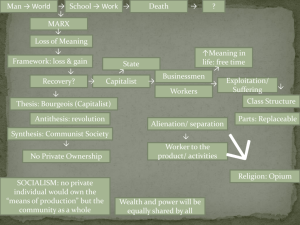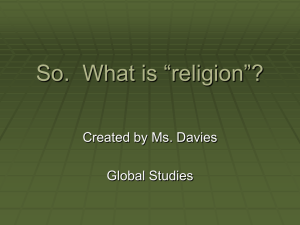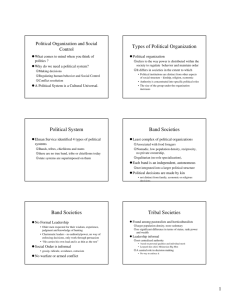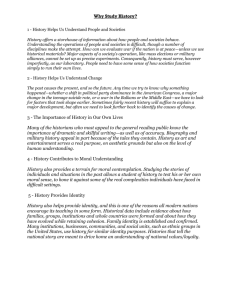12. Functions of religion
advertisement
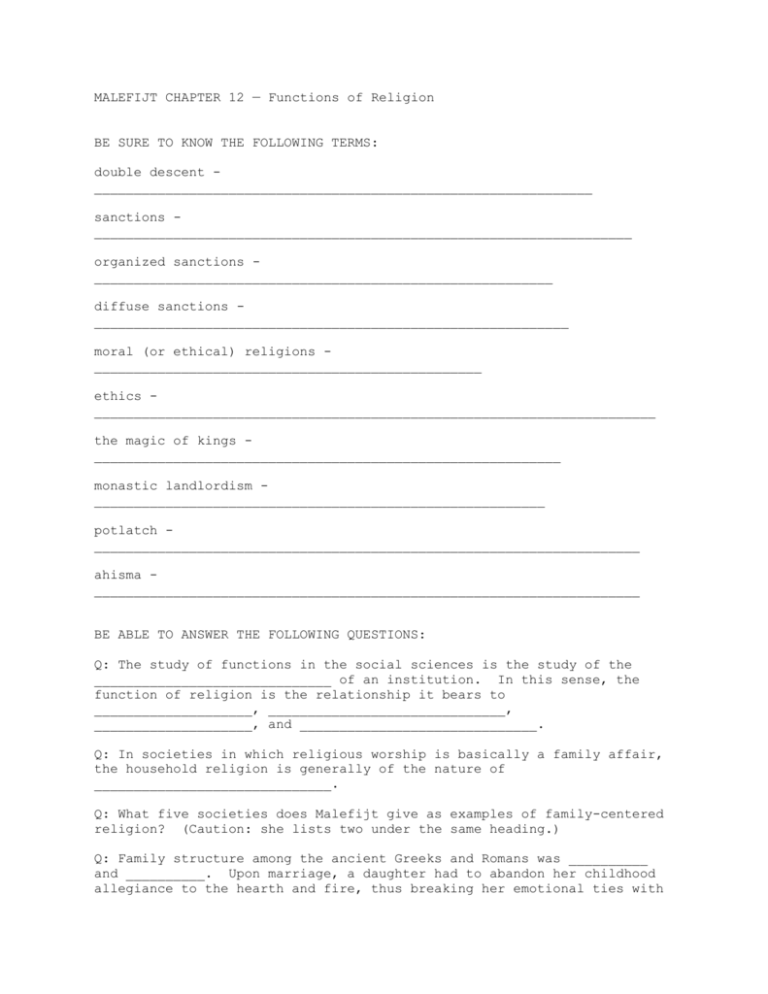
MALEFIJT CHAPTER 12 — Functions of Religion BE SURE TO KNOW THE FOLLOWING TERMS: double descent _______________________________________________________________ sanctions ____________________________________________________________________ organized sanctions __________________________________________________________ diffuse sanctions ____________________________________________________________ moral (or ethical) religions _________________________________________________ ethics _______________________________________________________________________ the magic of kings ___________________________________________________________ monastic landlordism _________________________________________________________ potlatch _____________________________________________________________________ ahisma _____________________________________________________________________ BE ABLE TO ANSWER THE FOLLOWING QUESTIONS: Q: The study of functions in the social sciences is the study of the ______________________________ of an institution. In this sense, the function of religion is the relationship it bears to ____________________, ______________________________, ____________________, and ______________________________. Q: In societies in which religious worship is basically a family affair, the household religion is generally of the nature of ______________________________. Q: What five societies does Malefijt give as examples of family-centered religion? (Caution: she lists two under the same heading.) Q: Family structure among the ancient Greeks and Romans was __________ and __________. Upon marriage, a daughter had to abandon her childhood allegiance to the hearth and fire, thus breaking her emotional ties with ______________________________. The husband had to bring a stranger to the sacred hearth and share with her the ceremonies of his lineage ancestors. The resultant sacred ties between husband and wife meant that marriage ______________________________. Only in later years, when ____________________ became powerful, was this stable system disrupted. Q: The Dobu stand in great contrast to the ancient Greeks and Romans. They are __________ rather than patrilineal. However, a much greater difference is that each marriage partner among the Dobu clings tenaciously to ____________________ ________________________________________. This Dobu practice weakens _______________ ties but supports _______________ cohesion. Q: The Yakö practice ____________________, which means that each individual belongs to both his father's patrilineage and his mother's matrilineage. However, the religious structure among the Yakö functions to __________ the lineages rather than __________ them. The Yakö are polygynous and ____________. The spirits of the patrilineage function primarily as _______________, while those of the matrilineage also promote _______________. The authority of the _______________ priests is greater in both the secular and religious realms. A man inherits _______________ property from his mother's brother and _______________ property from his father. Q: Among the Manus, religious is strongly __________-centered. Every house has its own supernatural ancestor, called "_____ _____." When he observes moral violations, his punishments are not necessarily visited upon the offender, but may be on any ______________________________. Likewise, he may punish a visitor or one of the visitor's _______________. To determine who is responsible, a _______________ goes to all the households to question each household's supernatural ancestor. Once he determines the culprit, he makes his findings public and demands ______________________________. Q: Some religious systems impinge on nearly every important form of social interaction, while others leave punishment of deviant behavior largely to ______________________________. Q: Malefijt observes that there is no one-to-one correlation between a society's technological development and the moral extent of its religion. However, ____________________ held that the moral constraint of society and its religious system were one and the same. Q: Eskimo social organization has no ______________________________, no ______________________________ with political authority. Leaders are recognized for specific tasks but have no power to ______________________________. In cases of morally deviant behavior such as murder and theft, supernatural punishment is likewise not expected. Religious sanctions in Eskimo society operate in relation to ______________________________. Perhaps the most important taboo is that forbidding ____________________________________________. If the rules based on that taboo are violated, it is thought that the individual will ___________________________ and that the supernatural powers would withhold _________________________________________________________________________ ______. Q: The Nuer, like the Eskimo, lack ______________________________. However, there are individuals called ______________________________ whom the Nuer can go to mediate disputes. This kind of "chief" finds out how much the offender's kin are willing to pay in ______________________________, and attempts to persuade the relatives of the offended person to accept the payment. Serious crimes are thought to automatically result in supernatural, physical ____________________ of the wrongdoer and his kin, which can only be redressed by _______________, _______________, and _______________. Q: In general, it may be noted that in societies where _______________ is prominent that religious sanctions can be expected to function strongly. Religious sanctions can likewise be expected to function strongly in societies that practice ______________________________, provided that living parents usually punish their errant children. Q: Religious systems may also function to maintain social order by ______________________________ the offices of those whose task it is to regulate and maintain social order. Q: Malefijt mentions four ways that religious systems validate political power. 1) __________ may relate how the social and political order came into existence. 2) Another powerful sanction, found most often in politically complex societies, is the belief that the ruler is ____________________ of a god. (The Egyptian pharaoh was given as an example.) However, failure of the ruler to live up to the ideal behavior can lead to his removal by ____________________. 3) Another religious concept sometimes upholding political power is the belief that the ruler has ______________________________ to supernatural powers; Frazer called this phenomenon ______________________________. There is evidence that rulers were sometimes ____________________ as soon as they showed signs of failing strength. 4) Finally, ____________________ functionaries tend to have a stabilizing influence on the political equilibrium. They __________ and __________ the ruler's actions, often wielding a considerable amount of political influence. Q: Malefijt points out how the three traditional subdivisions of economy — _______________, _______________, and _______________ — relate to religious beliefs and actions. She notes that the majority of the rituals in the __________ and __________ societies appear to be carried out to produce rain and thus ensure or increase crop yields. Q: The support of religious specialists is accomplished in a variety of ways. When the number of specialists is small and their duties include household services, ____________________________________________________________ constitutes the major part of their income. However, full-time specialists are usually in charge of shrines and have communal ritual duties. They may then be __________________________________________________. Alternatively, ________________________________________ may form a substantial part of the priests' income; ancient Hebrew, Roman, and Greek practices were given as examples. Religious specialists may also be partially or totally supported by the __________. Q: Religious ritual not only involves offerings to gods and payments to priests, but is frequently accompanied by ______________________________ among the participants. The function of ritual as a convenient setting for exchange is particularly important in _____________________________________________________. Q: There is also a relationship between religion and markets. In ______________________________, rulers and bishops protected merchants on their way to and from markets. _______________ markets were often religiously founded. Q: In societies that are organized along the lines of status equality, the culture provides means for liquidating property that might otherwise upset the economic status balance. Quite frequently, this siphoning off of extra goods takes the form of ______________________________. One example is that of the ____________________; every year, the eight most affluent men are chosen to sponsor the annual harvest ceremony. Another example is that of the Kwakiutl, who were famous for their ritual destruction of property in ceremonies called __________. Finally, Malefijt mentions many instances in which goods are destroyed or considered unfit for further use after ______________________________; the Kazaks, Crow Indians, and ancient Egyptians were given as examples. Q: Although the orthodox Hindu treatment of cattle as sacred has been criticized as a case of religiously inspired resource mismanagement, Harris suggests that the relationship between human and bovine populations is _______________ rather than competitive.
